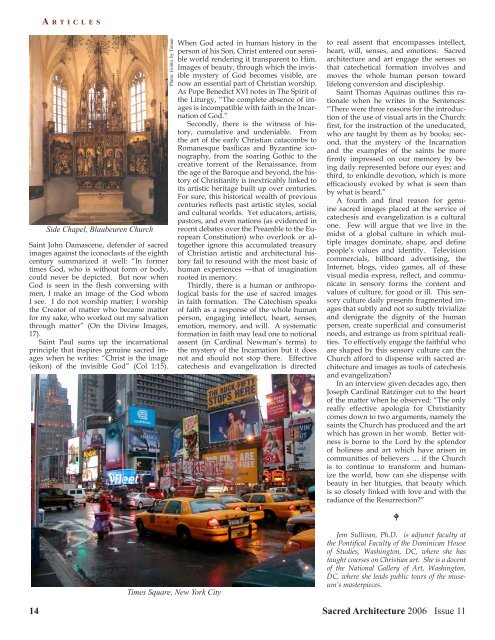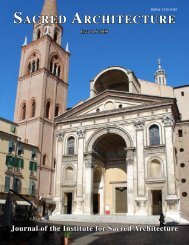Download Issue PDF - The Institute for Sacred Architecture
Download Issue PDF - The Institute for Sacred Architecture
Download Issue PDF - The Institute for Sacred Architecture
Create successful ePaper yourself
Turn your PDF publications into a flip-book with our unique Google optimized e-Paper software.
A R T I C L E S<br />
Side Chapel, Blaubeuren Church<br />
Saint John Damascene, defender of sacred<br />
images against the iconoclasts of the eighth<br />
century summarized it well: “In <strong>for</strong>mer<br />
times God, who is without <strong>for</strong>m or body,<br />
could never be depicted. But now when<br />
God is seen in the flesh conversing with<br />
men, I make an image of the God whom<br />
I see. I do not worship matter; I worship<br />
the Creator of matter who became matter<br />
<strong>for</strong> my sake, who worked out my salvation<br />
through matter” (On the Divine Images,<br />
17).<br />
Saint Paul sums up the incarnational<br />
principle that inspires genuine sacred images<br />
when he writes: “Christ is the image<br />
(eikon) of the invisible God” (Col 1:15).<br />
Photo: Gothic by Toman<br />
Times Square, New York City<br />
When God acted in human history in the<br />
person of his Son, Christ entered our sensible<br />
world rendering it transparent to Him.<br />
Images of beauty, through which the invisible<br />
mystery of God becomes visible, are<br />
now an essential part of Christian worship.<br />
As Pope Benedict XVI notes in <strong>The</strong> Spirit of<br />
the Liturgy, “<strong>The</strong> complete absence of images<br />
is incompatible with faith in the Incarnation<br />
of God.”<br />
Secondly, there is the witness of history,<br />
cumulative and undeniable. From<br />
the art of the early Christian catacombs to<br />
Romanesque basilicas and Byzantine iconography,<br />
from the soaring Gothic to the<br />
creative torrent of the Renaissance, from<br />
the age of the Baroque and beyond, the history<br />
of Christianity is inextricably linked to<br />
its artistic heritage built up over centuries.<br />
For sure, this historical wealth of previous<br />
centuries reflects past artistic styles, social<br />
and cultural worlds. Yet educators, artists,<br />
pastors, and even nations (as evidenced in<br />
recent debates over the Preamble to the European<br />
Constitution) who overlook or altogether<br />
ignore this accumulated treasury<br />
of Christian artistic and architectural history<br />
fail to resound with the most basic of<br />
human experiences —that of imagination<br />
rooted in memory.<br />
Thirdly, there is a human or anthropological<br />
basis <strong>for</strong> the use of sacred images<br />
in faith <strong>for</strong>mation. <strong>The</strong> Catechism speaks<br />
of faith as a response of the whole human<br />
person, engaging intellect, heart, senses,<br />
emotion, memory, and will. A systematic<br />
<strong>for</strong>mation in faith may lead one to notional<br />
assent (in Cardinal Newman’s terms) to<br />
the mystery of the Incarnation but it does<br />
not and should not stop there. Effective<br />
catechesis and evangelization is directed<br />
to real assent that encompasses intellect,<br />
heart, will, senses, and emotions. <strong>Sacred</strong><br />
architecture and art engage the senses so<br />
that catechetical <strong>for</strong>mation involves and<br />
moves the whole human person toward<br />
lifelong conversion and discipleship.<br />
Saint Thomas Aquinas outlines this rationale<br />
when he writes in the Sentences:<br />
“<strong>The</strong>re were three reasons <strong>for</strong> the introduction<br />
of the use of visual arts in the Church:<br />
first, <strong>for</strong> the instruction of the uneducated,<br />
who are taught by them as by books; second,<br />
that the mystery of the Incarnation<br />
and the examples of the saints be more<br />
firmly impressed on our memory by being<br />
daily represented be<strong>for</strong>e our eyes; and<br />
third, to enkindle devotion, which is more<br />
efficaciously evoked by what is seen than<br />
by what is heard.”<br />
A fourth and final reason <strong>for</strong> genuine<br />
sacred images placed at the service of<br />
catechesis and evangelization is a cultural<br />
one. Few will argue that we live in the<br />
midst of a global culture in which multiple<br />
images dominate, shape, and define<br />
people’s values and identity. Television<br />
commercials, billboard advertising, the<br />
Internet, blogs, video games, all of these<br />
visual media express, reflect, and communicate<br />
in sensory <strong>for</strong>ms the content and<br />
values of culture, <strong>for</strong> good or ill. This sensory<br />
culture daily presents fragmented images<br />
that subtly and not so subtly trivialize<br />
and denigrate the dignity of the human<br />
person, create superficial and consumerist<br />
needs, and estrange us from spiritual realities.<br />
To effectively engage the faithful who<br />
are shaped by this sensory culture can the<br />
Church af<strong>for</strong>d to dispense with sacred architecture<br />
and images as tools of catechesis<br />
and evangelization?<br />
In an interview given decades ago, then<br />
Joseph Cardinal Ratzinger cut to the heart<br />
of the matter when he observed: “<strong>The</strong> only<br />
really effective apologia <strong>for</strong> Christianity<br />
comes down to two arguments, namely the<br />
saints the Church has produced and the art<br />
which has grown in her womb. Better witness<br />
is borne to the Lord by the splendor<br />
of holiness and art which have arisen in<br />
communities of believers … if the Church<br />
is to continue to trans<strong>for</strong>m and humanize<br />
the world, how can she dispense with<br />
beauty in her liturgies, that beauty which<br />
is so closely linked with love and with the<br />
radiance of the Resurrection?”<br />
14 <strong>Sacred</strong> <strong>Architecture</strong> 2006 <strong>Issue</strong> 11<br />
W<br />
Jem Sullivan, Ph.D. is adjunct faculty at<br />
the Pontifical Faculty of the Dominican House<br />
of Studies, Washington, DC, where she has<br />
taught courses on Christian art. She is a docent<br />
of the National Gallery of Art, Washington,<br />
DC, where she leads public tours of the museum’s<br />
masterpieces.










